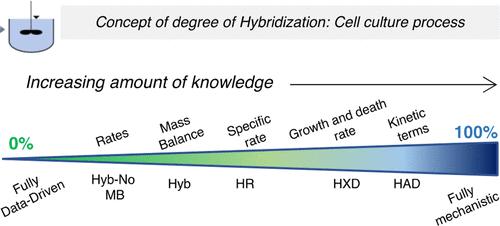当前位置:
X-MOL 学术
›
Ind. Eng. Chem. Res.
›
论文详情
Our official English website, www.x-mol.net, welcomes your
feedback! (Note: you will need to create a separate account there.)
Hybrid Models Based on Machine Learning and an Increasing Degree of Process Knowledge: Application to Cell Culture Processes
Industrial & Engineering Chemistry Research ( IF 3.8 ) Pub Date : 2022-06-16 , DOI: 10.1021/acs.iecr.1c04507 Harini Narayanan 1 , Martin Luna 1 , Michael Sokolov 2 , Alessandro Butté 2 , Massimo Morbidelli 2, 3
Industrial & Engineering Chemistry Research ( IF 3.8 ) Pub Date : 2022-06-16 , DOI: 10.1021/acs.iecr.1c04507 Harini Narayanan 1 , Martin Luna 1 , Michael Sokolov 2 , Alessandro Butté 2 , Massimo Morbidelli 2, 3
Affiliation

|
In this work, we aim to introduce the concept of the degree of hybridization for cell culture process modeling. We propose that a family of hybrid models can be created with varying fractions of process knowledge explicitly encoded in the model, defined as the degree of hybridization, with the two extremes being fully data-driven (0%) and fully mechanistic (100%) models. Subsequently, the aim is to compare the different models based on different metrics: model accuracy, the experimental effort for model development, extrapolation capability, the capability of generating new process understanding, and ease of utilization in practice, and to demonstrate that this could provide an additional degree of freedom for model selection. We could quantitatively demonstrate that for the cell culture process, either extreme has limitations. The major drawback of the data-driven model is the poor performance at low data availability as well as poor extrapolation capability, inability to provide process understanding, and subsequently inefficient practical application. On the other hand, the mechanistic model has poor accuracy due to the addition of excessive knowledge that then biases the models. Moving from data-driven to mechanistic models, the performance of the models improves progressively, as long as the knowledge added is not too biased. We show that the choice of the hybrid models to be used is based on the goal of model development. For instance, hybrid models including mass balances on each species show better performance in transferring models across different modes of operation. On the other hand, models with a higher degree of hybridization allow for more process interpretation possibilities. For modeling accuracy, amount of training data, extrapolation, and practical applications, the Hybrid Rate (HR) model is found to have the optimal degree of hybridization. This is likely due to the compromise between adding process knowledge and increasing the model parameters achieved by the HR model. The HR model features the incorporation of mass balance and channels the data-driven modeling to cell-specific rates, and thus these two pieces of information appear to be the most crucial ones. Finally, we believe that the concept will be instrumental in progressively developing and testing hypotheses about complex processes such as cell cultures.
中文翻译:

基于机器学习和越来越多的过程知识的混合模型:在细胞培养过程中的应用
在这项工作中,我们旨在为细胞培养过程建模引入杂交程度的概念。我们建议可以使用模型中明确编码的不同部分的过程知识来创建一系列混合模型,定义为混合程度,两个极端是完全数据驱动 (0%) 和完全机械化 (100%)楷模。随后,目的是根据不同的指标比较不同的模型:模型准确性、模型开发的实验工作量、外推能力、产生新过程理解的能力以及在实践中的易用性,并证明这可以提供模型选择的额外自由度。我们可以定量地证明,对于细胞培养过程,任何一个极端都有局限性。数据驱动模型的主要缺点是在低数据可用性以及外推能力差的情况下表现不佳,无法提供过程理解,从而导致实际应用效率低下。另一方面,机械模型由于添加了过多的知识而导致模型的偏差,因此准确性较差。从数据驱动模型转向机械模型,只要添加的知识不太偏颇,模型的性能就会逐渐提高。我们表明,要使用的混合模型的选择是基于模型开发的目标。例如,包括每个物种的质量平衡的混合模型在跨不同操作模式转移模型时表现出更好的性能。另一方面,具有更高杂交程度的模型允许更多的过程解释可能性。对于建模精度、训练数据量、外推和实际应用,发现混合率(HR)模型具有最佳的杂交程度。这可能是由于增加流程知识和增加 HR 模型实现的模型参数之间的折衷。HR 模型的特点是结合了质量平衡并将数据驱动的建模引导到细胞特定的速率,因此这两条信息似乎是最关键的信息。最后,我们相信这个概念将有助于逐步开发和测试关于细胞培养等复杂过程的假设。在实际应用中,发现杂交率(HR)模型具有最佳的杂交度。这可能是由于增加流程知识和增加 HR 模型实现的模型参数之间的折衷。HR 模型的特点是结合了质量平衡并将数据驱动的建模引导到细胞特定的速率,因此这两条信息似乎是最关键的信息。最后,我们相信这个概念将有助于逐步开发和测试关于细胞培养等复杂过程的假设。在实际应用中,发现杂交率(HR)模型具有最佳的杂交度。这可能是由于增加流程知识和增加 HR 模型实现的模型参数之间的折衷。HR 模型的特点是结合了质量平衡并将数据驱动的建模引导到细胞特定的速率,因此这两条信息似乎是最关键的信息。最后,我们相信这个概念将有助于逐步开发和测试关于细胞培养等复杂过程的假设。HR 模型的特点是结合了质量平衡并将数据驱动的建模引导到细胞特定的速率,因此这两条信息似乎是最关键的信息。最后,我们相信这个概念将有助于逐步开发和测试关于细胞培养等复杂过程的假设。HR 模型的特点是结合了质量平衡并将数据驱动的建模引导到细胞特定的速率,因此这两条信息似乎是最关键的信息。最后,我们相信这个概念将有助于逐步开发和测试关于细胞培养等复杂过程的假设。
更新日期:2022-06-16
中文翻译:

基于机器学习和越来越多的过程知识的混合模型:在细胞培养过程中的应用
在这项工作中,我们旨在为细胞培养过程建模引入杂交程度的概念。我们建议可以使用模型中明确编码的不同部分的过程知识来创建一系列混合模型,定义为混合程度,两个极端是完全数据驱动 (0%) 和完全机械化 (100%)楷模。随后,目的是根据不同的指标比较不同的模型:模型准确性、模型开发的实验工作量、外推能力、产生新过程理解的能力以及在实践中的易用性,并证明这可以提供模型选择的额外自由度。我们可以定量地证明,对于细胞培养过程,任何一个极端都有局限性。数据驱动模型的主要缺点是在低数据可用性以及外推能力差的情况下表现不佳,无法提供过程理解,从而导致实际应用效率低下。另一方面,机械模型由于添加了过多的知识而导致模型的偏差,因此准确性较差。从数据驱动模型转向机械模型,只要添加的知识不太偏颇,模型的性能就会逐渐提高。我们表明,要使用的混合模型的选择是基于模型开发的目标。例如,包括每个物种的质量平衡的混合模型在跨不同操作模式转移模型时表现出更好的性能。另一方面,具有更高杂交程度的模型允许更多的过程解释可能性。对于建模精度、训练数据量、外推和实际应用,发现混合率(HR)模型具有最佳的杂交程度。这可能是由于增加流程知识和增加 HR 模型实现的模型参数之间的折衷。HR 模型的特点是结合了质量平衡并将数据驱动的建模引导到细胞特定的速率,因此这两条信息似乎是最关键的信息。最后,我们相信这个概念将有助于逐步开发和测试关于细胞培养等复杂过程的假设。在实际应用中,发现杂交率(HR)模型具有最佳的杂交度。这可能是由于增加流程知识和增加 HR 模型实现的模型参数之间的折衷。HR 模型的特点是结合了质量平衡并将数据驱动的建模引导到细胞特定的速率,因此这两条信息似乎是最关键的信息。最后,我们相信这个概念将有助于逐步开发和测试关于细胞培养等复杂过程的假设。在实际应用中,发现杂交率(HR)模型具有最佳的杂交度。这可能是由于增加流程知识和增加 HR 模型实现的模型参数之间的折衷。HR 模型的特点是结合了质量平衡并将数据驱动的建模引导到细胞特定的速率,因此这两条信息似乎是最关键的信息。最后,我们相信这个概念将有助于逐步开发和测试关于细胞培养等复杂过程的假设。HR 模型的特点是结合了质量平衡并将数据驱动的建模引导到细胞特定的速率,因此这两条信息似乎是最关键的信息。最后,我们相信这个概念将有助于逐步开发和测试关于细胞培养等复杂过程的假设。HR 模型的特点是结合了质量平衡并将数据驱动的建模引导到细胞特定的速率,因此这两条信息似乎是最关键的信息。最后,我们相信这个概念将有助于逐步开发和测试关于细胞培养等复杂过程的假设。











































 京公网安备 11010802027423号
京公网安备 11010802027423号